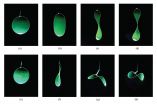Shifting boundaries and changing surfaces
2014-12-10
(Press-News.org) This news release is available in Japanese.
New research published in the Proceedings of The Royal Society A by members of the Mathematical Soft Matter Unit at the Okinawa Institute of Science and Technology Graduate University examines the energies at work in a closed flexible loop spanned by a soap film. While the underlying experiments are simple enough to be replicated in a kitchen sink, the research generates potentially important questions and changes how we think about different disciplines from material science to vertebrate morphogenesis. Aisa Biria and Professor Eliot Fried, who heads the unit, conducted the research.
The problem of determining the shape of a soap film that spans a given rigid frame goes back to experiments first conducted by Joseph Plateau in the 1870s. Due to the rigidity of the boundary, only the surface energy of the soap film plays a role in these experiments. In the experiments that inspired this work, OIST Prof. Fried explains that "you have not only the surface tension caused by the soap film, but also energy resulting from the resistance of the loop material to bending and twisting. These energies compete to influence the equilibrium states accessible to the model."
A work published by Luca Giomi and L. Mahadevan in 2012, which served as the foundation for the research done at OIST, focused on a model in which two energies competed: surface tension from a spanning soap film and the flexural resistance of the bounding loop. As the length of the loop increases, the resistance of the bounding loop decreases and experiments and numerical simulations found a wide range of equilibrium states where the surface tension of the soap films buckles the loop, creating a multitude of different non-flat shapes. The recent work published by the OIST Mathematical Soft Matter unit examines the next logical problem of how energy associated with the resistance of the loop to twisting about its axis influences the collection of energetically favorable equilibrium states.
The studies, which take into account the energies associated with surface tension and with the bending and twisting of the loop, show both physically and mathematically the points at which these energies overtake one another and act to alter the shape of the loop and the soap film that spans it. Specifically the new research demonstrates the stabilizing effect of torsional rigidity or resistance to twisting within these models.
The study of loops that can both twist and bend in response to an applied surface tension provides a simple model for various biological systems where elastic filaments or tubes are spanned by membranes. Such naturally occurring structures include high-density lipoproteins, which transport various forms of cholesterol around the body, and the dorsal mesentery, namely the membrane inside the gut which suspends internal structures like the colon. The 2012 work of Giomi and Mahadevan, which this newest paper continues to build upon, already drew connections to bending and surface tension energies as being both problematic and also a key regulator of vertebrate gut formation. Adding to this the effect of twisting allows future researchers to ask questions about the role such competing energies play in health problems related to highly twisted intestines.
INFORMATION:
[Attachments] See images for this press release:


ELSE PRESS RELEASES FROM THIS DATE:
2014-12-10
UNIVERSITY OF CALIFORNIA, BERKELEY'S HAAS SCHOOL OF BUSINESS -Too many vehicles on the highway inevitably slow down traffic. On the Internet information highway, consumers value high-speed Internet service, but there is little reason to think broadband traffic congestion will improve if the Federal Communications Commission abandons net neutrality, according to economic research.
In their paper, "The Economics of Network Neutrality," Ben Hermalin, Haas Economics Analysis and Policy Group, and Nicholas Economides, Berkeley-Haas visiting professor from NYU'S Stern School ...
2014-12-10
Scientists at the University of Strathclyde and City University of New York have created methods that dramatically simplify the discovery of biological gels for food, cosmetics and biomedicine, as published in the journal Nature Chemistry.
Strathclyde's Dr Tell Tuttle and Professor Rein Ulijn, the director of nanoscience at City University New York's new advanced research centre who also holds a position at Strathclyde, believe their team's breakthrough dramatically simplifies discovery of functional gels that can be used in a wide range of applications.
Until now, ...
2014-12-10
The drug daclatasvir (trade name Daklinza) has been available since August 2014 for the treatment of adults with chronic hepatitis C (CHC) infection. The German Institute for Quality and Efficiency in Health Care (IQWiG) examined in a dossier assessment whether this new drug offers an added benefit over the appropriate comparator therapy.
The drug manufacturer presented data for patients without cirrhosis of the liver who are infected with hepatitis C virus (HCV) genotype 1, and for patients with HCV genotype 4. However, these data are unsuitable in various aspects to ...
2014-12-10
Pioneering new research by the University of Exeter could revolutionise global diagnostic procedures for one of the most common forms of epilepsy.
Scientists from Exeter have investigated using mathematical modelling to assess susceptibility to idiopathic generalised epilepsy (IGE) by analysing electrical activity of the brain while the patient is in a resting state.
Current diagnosis practices typically observe electrical activities associated with seizures in a clinical environment.
The ground-breaking research has revealed differences in the way that distant regions ...
2014-12-10
"A tree must be bent while it is young," as one saying about learning a foreign language goes. In other words, the earlier you start learning a foreign language systematically, the better the language level will be in the long run. The second widely held view is that you need to be solid in your first language (L1) in order to develop good literacy skills in the foreign language. Linguist Simone Pfenninger from the University of Zurich has been examining these two myths in her five-year study involving Swiss high-school children in order to identify the optimal starting ...
2014-12-10
Reston, Va. (December 9, 2014) - Cancer therapy can be much more effective using a new way to customize nuclear medicine treatment, researchers say in the December 2014 issue of The Journal of Nuclear Medicine. The process could also be useful for other diseases that could benefit from targeted radiation.
Targeted therapy with radiopharmaceuticals--radioactive compounds used in nuclear medicine for diagnosis or treatment--has great potential for the treatment of cancer, especially for cancer cells that have migrated from primary tumors to lymph nodes and secondary organs ...
2014-12-10
London, United Kingdom, December 9, 2014 - As the Ebola Virus Diseases (EVD) epidemic continues to rage in West Africa, infectious diseases experts call attention to the striking lack of treatment guidelines. With over 16,000 total cases and more than 500 new infections reported per week, and probable underreporting of both cases and fatalities, the medical community still does not have specific approved treatment in place for Ebola, according to an editorial published in the International Journal of Infectious Diseases.
Not only are treatment guidelines lacking, but ...
2014-12-10
Studying the social interaction of bears through the use of camera traps and visual observations requires that humans be able to tell individuals apart. A study done using volunteers to study the vulnerable Andean bear indicates that people can learn to identify individual bears, given a little practice. The research, done by San Diego Zoo conservationists with international collaborators using photos spanning many years, also indicates that young bears usually retain many of their unique markings as they grow older.
"Knowing, scientifically, that people who have been ...
2014-12-10
Researchers from Johannes Gutenberg University Mainz (JGU) and the Julius Maximilian University of Würzburg are proposing potential new active substances for treating the dengue virus. Just like Ebola, dengue fever is also caused by a virus for which there is currently no cure and no vaccine and can be fatal.
In the quest for medication to treat the dengue virus, the scientific community is focusing on a particular enzyme of the pathogen, the protease known as NS2B/NS3. The reason for this is that inhibitors of similar proteases have been revealed to be very effective ...
2014-12-10
JACKSONVILLE, Fla. -- A marker of immune function that predicts for better outcomes in patients treated with chemotherapy for triple negative breast cancer is also linked to improved prognosis in patients treated with chemotherapy for HER2-positive breast cancer. But that marker -- the quantity of tumor-infiltrating lymphocytes (S-TILs) in a biopsy -- appears irrelevant when trastuzumab is used.
And since trastuzumab, and not chemotherapy alone, is the standard of care for the HER2-positive sub-class of breast cancer, there is no need to test for these lymphocytes in ...
LAST 30 PRESS RELEASES:
[Press-News.org] Shifting boundaries and changing surfaces


